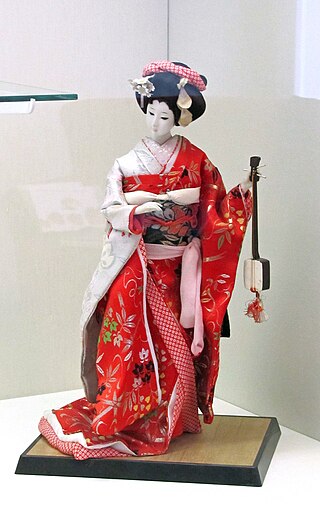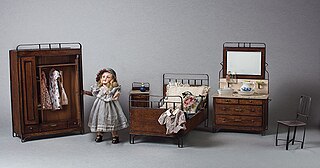
A doll is a model typically of a human or humanoid character, often used as a toy for children. Dolls have also been used in traditional religious rituals throughout the world. Traditional dolls made of materials such as clay and wood are found in the Americas, Asia, Africa and Europe. The earliest documented dolls go back to the ancient civilizations of Egypt, Greece, and Rome. They have been made as crude, rudimentary playthings as well as elaborate art. Modern doll manufacturing has its roots in Germany, from the 15th century. With industrialization and new materials such as porcelain and plastic, dolls were increasingly mass-produced. During the 20th century, dolls became increasingly popular as collectibles.

An action figure is a poseable character model figure made most commonly of plastic, and often based upon characters from a film, comic book, military, video game or television program; fictional or historical. These figures are usually marketed toward boys and adult collectors. The term was coined by Hasbro in 1964 to market G.I. Joe to boys.

A bobblehead, also known by nicknames such as nodder, wobbler, or wacky wobbler, is a type of small collectible figurine. Its head is often oversized compared to its body. Instead of a solid connection, its head is connected to the body by a spring or hook in such a way that a light tap will cause the head to move around, or "bobble," hence the name.

Japanese dolls are one of the traditional Japanese crafts.

Biscuit porcelain, bisque porcelain or bisque is unglazed, white porcelain treated as a final product, with a matte appearance and texture to the touch. It has been widely used in European pottery, mainly for sculptural and decorative objects that are not tableware and so do not need a glaze for protection.
A celebrity doll is a doll modeled after a celebrity.

Fashion dolls are dolls primarily designed to be dressed to reflect fashion trends. They are manufactured both as toys for children to play with and as collectibles for adults. The dolls are usually modeled after teen girls or adult women, though child, male, and even some non-human variants exist. Contemporary fashion dolls are typically made of vinyl or another plastic.

Bleuette is a doll that was produced from 1905 to 1960 in France and was available to readers of the girls' magazine La Semaine de Suzette, or the English version, "Suzette's Week".
The Société Française de Fabrication de Bébés et Jouets was a large doll making consortium founded in France by the union of a number of major French doll companies including Jumeau and Bru and the Franco-German doll company Fleischmann & Bloedel in 1899. The company went out of business in the late 1950s.

Ideal Toy Company was an American toy company founded by Morris Michtom and his wife, Rose. During the post–World War II baby boom era, Ideal became the largest doll-making company in the United States. Their most popular dolls included Betsy Wetsy, Toni, Saucy Walker, Shirley Temple, Miss Revlon, Patti Playpal, Tammy, Thumbelina, Tiny Thumbelina, and Crissy. The company is also known for selling the Rubik's Cube.

Shindana Toys, a division of Operation Bootstrap, Inc., was a South Central Los Angeles, California cooperative toy company in business from 1968 to 1983. It was launched as a black empowerment and community rejuvenation effort following the Watts riots. Company proceeds supported businesses in the Watts area. Named after the Swahili word roughly meaning "to compete," Shindana Toys was community-owned and founded by Louis S. Smith, II and Robert Hall. The latter was the company's first CEO and President; though he was succeeded in both posts by Smith. The Chase Manhattan Bank, the Mattel Toy Company, Sears Roebuck & Co., and Equitable Life Assurance helped finance portions of the Shindana Toys operations.

A china doll is a doll made partially or wholly out of glazed porcelain. The name comes from china being used to refer to the material porcelain. Colloquially the term china doll is sometimes used to refer to any porcelain or bisque doll, but more specifically it describes only glazed dolls.
A Black doll is a doll of a black person. Black doll manufacture dates back to the 19th century, with representations being both realistic and stereotypical. More accurate, mass-produced depictions are manufactured today as toys and adult collectibles.

"Parian" is a term misapplied to a type of bisque shoulder head dolls manufactured primarily in Germany in the last quarter of the 19th century, from around 1860 to 1880. The origin of the term "parian" comes from the white marble from the island of Paros. The proper descriptive term for these dolls is "bisque". These shoulder head dolls have a body made from fabrics and a head created from very lightly tinted or untinted white porcelain. Unlike the china doll however, the bisque doll's head is not dipped in glaze before firing and as such has a matte finish, giving it a markedly different appearance. The UFDC still perpetuates the incorrect definition of these dolls is as follows: "Parian doll: doll made of fine white bisque without tinting. The features, hair and cheeks may be painted." Many collectors now are discarding the term parian in favor of untinted bisque versus tinted bisque.

Pierre-François Jumeau, was the founder of Jumeau. Jumeau was an 1840s French firm that produced bisque dolls and china dolls. His second son Emile-Louis Jumeau, born in 1843, began assuming management of the company in the 1870s.

Jumeau was a French company, founded in the early 1840s, which designed and manufactured high quality bisque dolls.
Mildred Seeley was a doll collector, doll-related entrepreneur, and prolific author on the subjects of doll making and doll collecting.

A bisque doll or porcelain doll is a doll made partially or wholly out of bisque or biscuit porcelain. Bisque dolls are characterized by their realistic, skin-like matte finish. They had their peak of popularity between 1860 and 1900 with French and German dolls. Bisque dolls are collectible, and antique dolls can be worth thousands of dollars. Antique German and French bisque dolls from the 19th century were often made as children's playthings, but contemporary bisque dolls are predominantly made directly for the collectors market.

Kewpie is a brand of dolls and figurines that were conceived as comic strip characters by cartoonist Rose O'Neill. The illustrated cartoons, appearing as baby cupid characters, began to gain popularity after the publication of O'Neill's comic strips in 1909, and O'Neill began to illustrate and sell paper doll versions of the Kewpies. The characters were first produced as bisque dolls in Waltershausen, Germany, beginning in 1912, and became extremely popular in the early 20th century.

Simon & Halbig was a doll manufacturer known for bisque doll heads with subtle colouring. They were based in Thuringia, the centre of the German doll industry. They supplied doll heads to many other well known doll makers. These are now collectables.

















